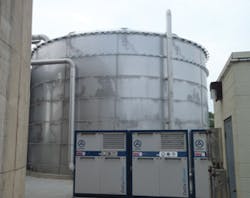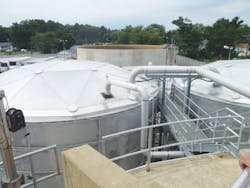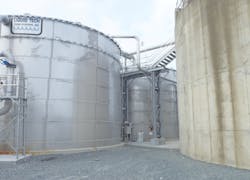in High-Strength Poultry Processing Wastewaters
By Jim McMahon
The latest moving bed biofilm reactors (MBBRs), designed by World Water Works, provide efficient reduction of total Kjeldahl nitrogen (TKN), biochemical oxygen demand (BOD) and total suspended solids (TSS) in challenging poultry processing wastewaters with high fats, oils and grease (FOG) content.
Poultry processing is a relatively high water usage activity, as is typical in many food processing sectors. For chicken broilers, for example, five to ten gallons of water are needed to process one five-pound, average-sized bird. It is not unusual for a medium-sized chicken processor to generate 800,000 to 1,000,000 gallons of wastewater daily. This water is laden with proteins, fats and carbohydrates from meat, fat, blood, skin and feathers. Wastewaters containing a high content of fat, oil and grease can present a significant challenge for treatment. The effluent is typically also polluted with a fair amount of grit and other inorganic matter.
Poultry processing plants are required to remove the majority of this soluble and particulate organic material from their wastewater prior to discharge to municipal sewer systems or streams to achieve compliance with local, State and Federal environmental regulations.
Although all food processors have to deal with wastewater generated in their plants, the characteristics of the effluent exiting their facilities can vary greatly. Waste load is determined by a number of different measurements, including BOD (biochemical oxygen demand), TSS (total suspended solids concentration), COD (chemical oxygen demand) and FOG (concentrations of fats, oils and grease). But poultry plant wastewater is most often tested for BOD — a measure of the amount of oxygen needed to degrade the organic matter, like feathers, fat and blood, in the wastewater.
Municipalities have long used BOD loads to determine charges and surcharges for poultry processing wastewater discharges. Now, with recent limits set on total Kjeldahl nitrogen (TKN) levels, many poultry processors have had to confront making system changes to their wastewater treatment plants to meet new allowable mandates set by the U.S. Environmental Protection Agency, or face additional surcharges for excessive total nitrogen.
To reach acceptable total nitrogen levels, and efficiently process high-strength organic content wastewater, World Water Works has developed a two-stage moving bed biofilm reactor (MBBR) system, followed by a dissolved air flotation process (DAF) to clarify the biological solids that are produced during the MBBR processes.
Two-Stage Moving Bed Biofilm Reactor
MBBRs use the advantages of activated sludge and other biofilm systems. The first MBBR in the duo-bioreactor process is designed to remove BOD from the wastewater stream. The second MBBR is used for nitrogen removal. The duo MBBRs, operating at a temperature range of 15° to 30° C, allow specialized bacteria growth in each reactor.
Significant reductions in BOD must be achieved to get to the ammonia/TKN constituent. The bacteria that are consuming the organic BOD would out-compete the nitrifiers. To guarantee reaching effluent ammonia concentration to comply with EPA requirements, all of the BOD needs to be removed prior to nitrification. With the two MBBRs in sequence, the first is removing the majority of the BOD and some nitrification, the second reactor is strictly for denitrification.
The basis of the process is the biofilm carrier elements that are made from high-density polyethylene. The elements provide a large protected surface area for the biofilm and optimal conditions for the bacteria culture to grow and for the degradation of the BOD, NH3-N and NO3-N. This technology combines a unique fully open and fully protected biomass carrier with a highly efficient aeration and mixing design. This results in superior effective surface area for biomass growth, optimal oxygen transfer efficiency and minimizes mass transfer boundary layer effects.
The biofilm protects the bacterial cultures from operating excursions in pH and temperature, and from toxic shocks to yield a very robust system in spite of process fluctuations.
Less space is required compared to other biological systems and far less control factors needed. Nutrient levels and dissolved oxygen (DO) levels are the only control points required for the system.
An aeration grid mounted at the bottom of the reactor provides the bacteria with the necessary oxygen required and the operators with minimal maintenance. The grid design provides the necessary turbulence and mixing to enhance the mass transfer of oxygen and wastewater flow across the biofilm creating optimal conditions for degradation of the BOD, NH3-N or NO3-N. The grid design also handles the intense weight of the biofilm carriers in the event that the reactor needs to be drained.
MBBR Integrated with Dissolved Air Flotation
In the MBBRs, the bacterial cultures digest the soluble organics and gradually mature, sloughing from the media and forming natural flocs. To provide efficient removal of the sloughed biomass and solids produced in the MBBRs, a DAF is coupled with the MBBR to provide a compact treatment system.
In the DAF process, micro-air bubbles cause suspended materials to float to the surface of a vessel to achieve liquid/solids separation. The wastewater first enters a low-shear mixing pipe flocculator where coagulants and flocculants are introduced to increase the particle size along with whitewater. The whitewater is a mixture of a portion of the DAF effluent, which has been saturated with atmospheric air via patented Nikuni® air dissolving technology. The wastewater then enters the vessel across the length of the system. The velocity of the water is significantly reduced to maximize separation potential.
Inside the vessel, the micro-bubbles, which have attached to the particle surface, affect the particle density, and cause the suspended solids to float to the surface where a chain and flight skim them from the surface into a top cone. Heavy sand and grit particles settle into the cone bottoms, where a timer function controls the removal. The clean liquid is continuously removed at several points inside the vessel and passes over pipe weirs into an effluent box. From the effluent box, the wastewater gravity feeds out of the system.
Such a DAF design, also engineered by World Water Works, represents a unique solution in dissolved air flotation. The system can achieve removal efficiencies and effluent qualities superior to traditional DAF systems.
Operational Flexibility and Efficiency
A control system, integrating the functions of the MBBRs with upstream and downstream plant processes, uses a programmable logic controller (PLC) to closely control operating parameters and chemical feed rates to achieve highly consistent and quality effluent conditions.
The controls software provides the functionality to trend operational data. It also allows operators to monitor the system from one location with a touch screen HMI (human/machine interface). The plant can be controlled and troubleshot from remote locations via the Internet.
The entire treatment system is automated. Operators can completely control the system from one location, or remotely on a laptop. Every pump and motor can be controlled from the computer screen, providing a very high level of operator flexibility and plant efficiency.
About the Author: Jim McMahon writes on water and wastewater technologies. His feature stories have appeared in hundreds of industrial and high-tech publications throughout the world and are read by more than 5 million readers monthly. He can be reached at [email protected].





